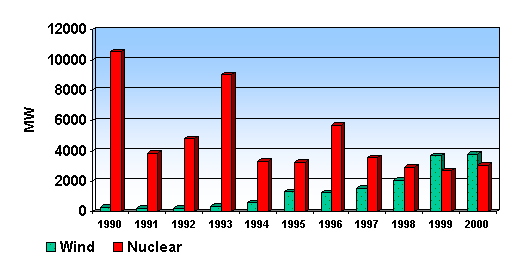 RÉSEAU
SOL(ID)AIRE DES ÉNERGIES !
RÉSEAU
SOL(ID)AIRE DES ÉNERGIES !
Débat problématique
énergétique / effet de serre / climat, etc.
NUCLEAIRE

122 C St., NW, Suite 380
Washington, D.C. 20001
(202) 383-2500 Fax (202) 383-2505
www.awea.org
FOR IMMEDIATE RELEASE: Contact:
Tom Gray (802) 649-2112
May 10, 2001 Christine Real de Azua (202) 383-2508
MORE NEW WIND GENERATING CAPACITY
THAN NUCLEAR
INSTALLED WORLDWIDE FOR SECOND YEAR
IN A ROW
Trade Group Predicts 2001 Will Follow Trend
As Global Wind Installations Rapidly Expand
Worldwide installations of wind energy generating capacity outstripped
those of nuclear for the second year in a row in 2000, an indication that
wind is becoming a competitive player in todayís power markets,
the American Wind Energy Association (AWEA) said today. The steady growth
of investment in wind farms makes it clear that deployment of wind power
can be part of the solution to Americaís energy crisis, according
to AWEA.
Additions to wind energy capacity worldwide totaled 3,800 megawatts
(MW) in 2000, according to figures from the European Wind Energy Association
(EWEA) and AWEA. Some 3,056 MW of new nuclear capacity was installed in
2000, according to the International Atomic Energy Agencyís (IAEA)
Public Reactor Information System. In 1999, additions to wind generating
capacity totaled 3,600 MW and additions to nuclear, 2,700 MW.
"The figures are in, and they demonstrate that wind power can play a
rapidly increasing role in our nationís energy portfolio and that
of any nation with a good wind resource," said AWEA Executive Director
Randall Swisher. "One need only look at the current pace of investments
in wind farms in the U.S. and at the industryís steady growth in
several European countries, to see that this is one of the most promising
power technologies in the market today." The wind industry is expected
to grow this year by 60% in the U.S., and 34% worldwide. Globally, new
wind turbines added this year will equal two large (1,000-MW) nuclear plants
in electrical generation capability.
Because nuclear plants operate more steadily, a given amount of nuclear
capacity will generate substantially more electricity than the same amount
of wind capacity. Even so, the fact that new wind capacity totals are beginning
to surpass those of nuclear appears to signal a long-term trend, reflecting
a combination of economic and environmental factors.
The cost of wind energy has declined steadily to a range that is more
than competitive today, at the most efficient wind farms, with that of
power from nuclear plants. Wind energyís low risk and predictable
cost (its fuel is free, not subject to fluctuations in price) are also
attractive factors for power companies and utilities. Nuclear power would
in many cases not be economically viable without government insurance for
catastrophic risk, such as that provided under the Price-Anderson Act in
the U.S. Concerns about investment risk, siting, processing of fuel, and
storage of radioactive waste have also dampened the development of the
nuclear power industry over the years.
Wind farms generate electricity without emissions of pollutants or of
carbon dioxide, the leading gas associated with global warming. Wind energy
was recently singled out by the U.N. Intergovernmental Panel on Climate
Change (IPCC) as a technology of choice to bring fresh power online without
contributing to global warming.
 Global wind energy capacity figures are
available from the Web at http://www.awea.org/faq/global2000.html
Global wind energy capacity figures are
available from the Web at http://www.awea.org/faq/global2000.html
. The IAEA report is located on the
Web site at http://www.iaea.org/programmes/a2/index.html.
Up to 1999, figures in the chart for new wind installations are from the
International Energy Agency.
* * *
The following is relevant background information
about wind energy in the U.S. and the world.
Growth of the Wind Energy Industry
- Total worldwide wind capacity today is approximately
17,300 MW, enough to generate about 37 billion kilowatt-hours of electricity
each year. This is about the same amount of electricity as 5 million average
California households (containing 12.5 million people) use.
- Wind energy was the world's fastest-growing energy
source during most of the 1990s, expanding at annual rates ranging from
25% to 35%. In 2000, about 3,800 MW of new wind capacity (a $4 billion
investment) was installed around the world, but only 53 MW of that total,
or a little more than 1%, was installed in the U.S. However, AWEA expects
as much as 1,500 MW of new wind capacity to be installed in the U.S. this
year.
- Leading states in terms of installed wind capacity
today are California (1,646 MW), Minnesota (272 MW), Iowa (242 MW), and
Texas (188 MW).
- U.S. wind potential is enormous--many times the
amount installed. California, for example, could conservatively install
an estimated 5,000 MW of wind capacity. Other western states have much
larger potential--e.g., Wyoming has more than 10 times California's. The
U.S. is, quite literally, a "Saudi Arabia of wind," with vast resources
throughout the Plains states.
Market Drivers Behind Wind Energy's Growth
(1) Federal government policy: The federal government
provides a tax credit of 1.5 cents per kWh (adjusted for inflation) for
electricity generated by a wind plant during its first 10 years of operation.
This credit is intended to "level the playing field" for wind, which must
compete with other energy industries that receive billions of dollars in
federal subsidies each year. The wind energy credit will expire at the
end of this year unless it is extended by Congress.
(2) State government policy: Several states, as
part of electric utility restructuring legislation, have enacted policies
to encourage clean energy sources like wind. The state of Texas, for example,
has passed a law requiring the construction of 2,000 MW of new renewable
energy generation by the year 2009, of which wind is expected to capture
a major share. New wind projects of 160 MW, 208 MW, and 82.5 MW have been
announced in Texas within the past few months.
(3) Declining costs: The cost of producing electricity
from wind energy has declined by more than 80%, from about 38 cents per
kilowatt-hour in the early 1980s to a current range of 3 to 6 cents/kWh
(levelized over a plant's lifetime including the federal wind energy Production
Tax Credit (PTC)). However, the cost of electricity from a wind plant varies
based on its size and the average wind speed. A large plant (50 MW and
up) at an excellent site (20 mph average) can deliver power for 3-4 cents/kWh;
electricity from a small plant (3 MW) at a moderate site (16 mph) may cost
up to 8 cents/kWh. In the not-too-distant future, analysts believe, wind
energy costs could fall even lower.
(4) The green power market: As the electricity market
becomes more competitive, utilities and other power suppliers are looking
for ways to differentiate their products. One of the best ways to do that
is to offer "green power"--electricity from clean energy sources like wind--at
a premium price. Today, over 190 utilities nationwide are selling wind-generated
electricity as part of green power programs, and consumer demand for green
power (even though still very small) is beginning to result in the building
of new wind power projects, including some in southern California.
Clean Energy Policy Options
(1) Renewables Portfolio Standard (RPS): The RPS
is a "minimum content requirement," which specifies that a certain minimum
percentage of electric power must be generated from renewable energy sources
(wind, solar, and others). Typically, RPS legislation provides that the
minimum percentage increase gradually over time to encourage the sustained,
orderly development of the renewable energy industries. Several states,
including Texas, have enacted RPS laws, and the concept is also being considered
by the U.S. Congress. More information on the RPS is available from http://www.awea.org/policy/index.html#RPS.
(2) Production Tax Credit (PTC): The U.S. government
currently provides a tax credit of 1.5 cents per kilowatt-hour (adjusted
for inflation) for all the electricity generated by a new wind plant during
its first 10 years of operation. Under current law, the credit is scheduled
to expire at the end of 2001. The American Wind Energy Association (AWEA)
is seeking its extension for at least five years. More information on the
PTC is available from http://www.awea.org/policy/index.html#PTC.
(3) Incentives for Small Wind Turbines: Tax incentives
or rebates help make the purchase of a small wind turbine for household
use more attractive to potential buyers. California currently provides
a rebate of up to 50% of the purchase price of a small turbine, and that
has helped to sharply increase demand for the units in the state.
(4) Research and Development: The U.S. Department
of Energyís wind energy research and development (R&D) program
has worked closely with wind energy companies in recent years to improve
wind technology and pursue innovative approaches to reducing costs. Funding
for the R&D program should be continued and, if possible, expanded.
(5) Disclosure of Energy Sources: AWEA also supports
"disclosure" laws, which require sellers of electricity to inform customers
of the sources of energy (coal, nuclear, natural gas, etc.) that are used
to generate the electricity. Such information is important for consumers
to be able to make intelligent choices in a competitive marketplace.
(6) Fair Transmission Policy: The nation's electricity
transmission system operates based on rules that were designed to fit the
characteristics of fossil fueled power plants. Congress should take appropriate
steps (including guidance to the Federal Energy Regulatory Commission and
the emerging Regional Transmission Organizations) to ensure that wind energy
is not disadvantaged in the market simply because it is an intermittent
power source.
Benefits of Wind Energy Development
- Wind energy provides both environmental and economic
benefits.
- Windy counties profit from wind development through:
(1) Tax Payments: Every 100 MW of wind development
generates about $1 million in property tax revenue. Development of another
1,500 MW of wind this year will mean $15 million annually in tax revenues
to rural communities.
(2) Jobs: Every 100 MW of wind development creates
about 500 job-years of employment. Installation of 1,500 MW will result
in 7,500 job-years.
(3) Payments to landowners: The development of 1,500
MW in the U.S. will mean annual payments of approximately $3 million to
farm and ranch landowners.
(4) Stable electricity prices: A recent study (January,
2000) found Iowa's electric utility customers could save over $300 million
over a 25-year period if a proposal to meet 10% of the state's electric
demand through wind energy is adopted. The savings result because the cost
of fossil fuels is expected to rise over time, while wind's costs decline.
Savings in California, where prices have skyrocketed because of supply
constraints, would be enormous.
(5) Reduced emissions of pollution and greenhouse
gases: A single 660-kW wind turbine will displace emissions of 1,100 tons
of carbon dioxide (the leading greenhouse gas), 6 tons of sulfur dioxide
(the leading component of acid rain), and 4 tons of nitrogen oxides (the
leading component of smog) every year, based on the U.S. average utility
fuel mix. 375 acres (more than half a square mile) of forest would be needed
to absorb the same amount of CO2.
# # #
AWEA, formed in 1974, is the national trade association
of the U.S. wind energy industry. The associationís membership includes
turbine manufacturers, wind project developers, utilities, academicians,
and interested individuals. More information on wind energy is available
at the AWEA web site


